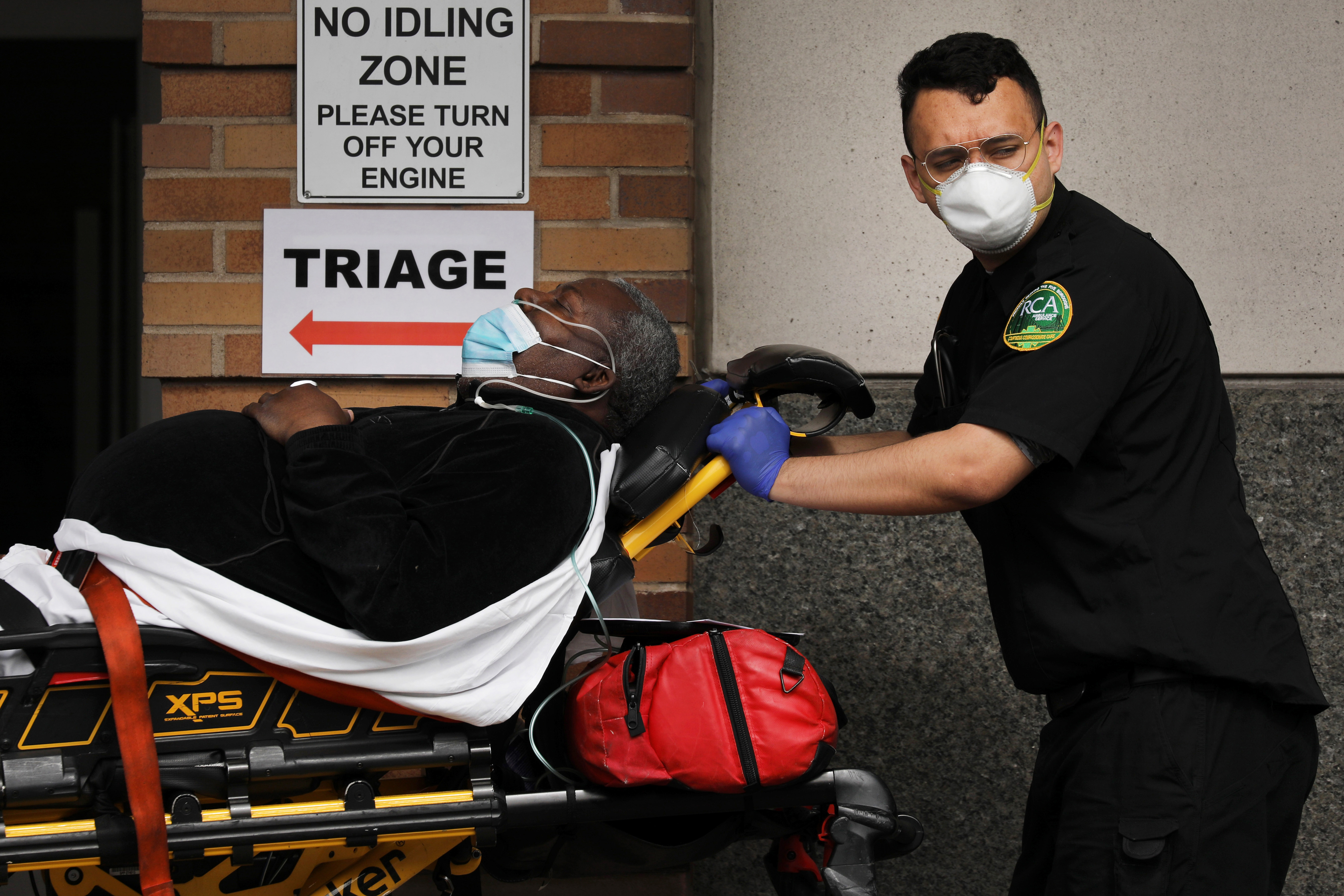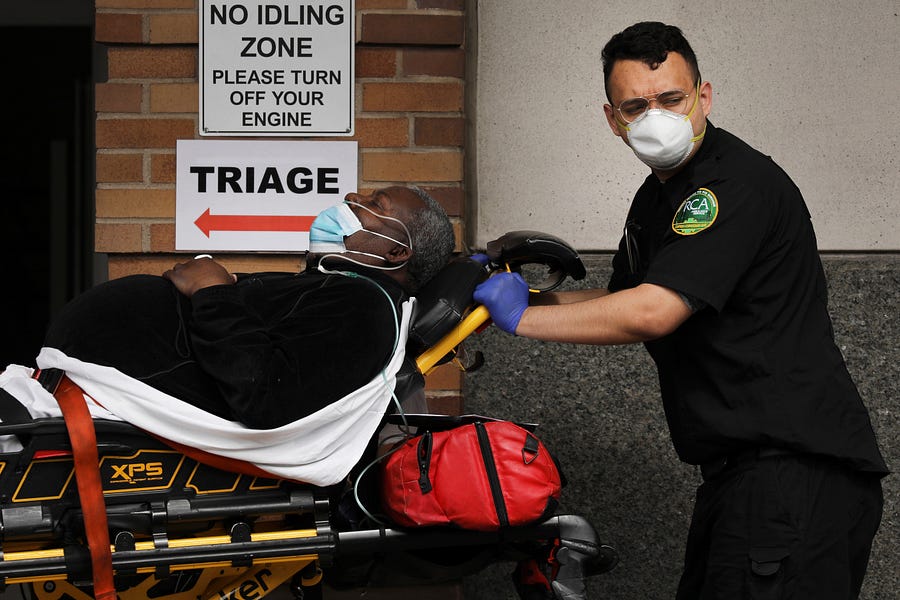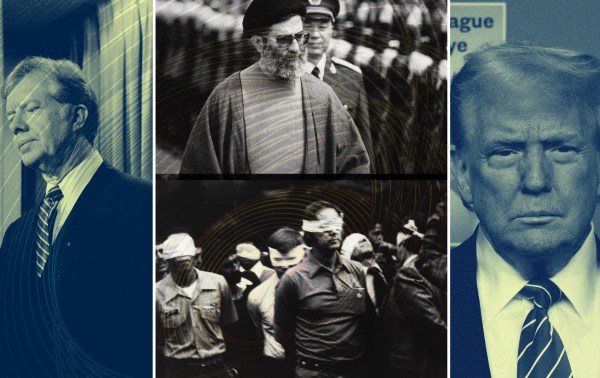Good Friday. See what we did there?
Quick Hits: Today’s Top Stories
-
As of Thursday night, there are now 465,750 confirmed cases of COVID-19 in the United States (a 7.8 percent increase from yesterday) and 16,690 deaths (a 12.6 percent increase from yesterday), according to the Johns Hopkins University COVID-19 Dashboard, leading to a mortality rate among confirmed cases of 3.6 percent (the true mortality rate is difficult to calculate due to incomplete testing regimens). Of 2,360,512 coronavirus tests conducted in the United States, 19.4 percent have come back positive, per the COVID Tracking Project, a separate dataset with slightly different topline numbers.
-
For the third straight week, U.S. unemployment numbers were even worse than most forecasts: Another 6.6 million filed jobless claims in the week ending April 4, bringing the total of newly unemployed Americans to nearly 17 million.
-
Attempts to approve still more financial relief for small businesses ran aground in the Senate Thursday, as Mitch McConnell and Chuck Schumer blocked each other’s attempts to pass competing packages by unanimous consent—all in a nearly deserted Capitol building.
-
Hospitals around the country have lost substantial income as a result of canceling or postponing non-urgent procedures to focus on treating coronavirus, and many are now struggling to pay their workers as a result.
-
Good news from across the pond: After spending three nights in the ICU, U.K. Prime Minister Boris Johnson is out of intensive care and “in good spirits,” his office announced Thursday.
-
A bipartisan group of senators, led by Lindsey Graham and Chris Coons, are calling on China to close all wet markets in the country, arguing that “the current moment … calls for extreme precautions.”
Back to the Well Already?
Senate Republicans hoped to approve another $250 billion in funding for the Paycheck Protection Program (PPP) on Thursday. Senate Democrats did too, but only if it was accompanied by an additional $250 billion for hospitals and local governments. Neither got what they wanted.
The PPP—created as part of the CARES Act signed into law late last month—was initially designed to provide $350 billion in loans for shuttered small businesses in an effort to keep workers employed. The loans would become forgivable—essentially grants—if businesses kept all workers on the payroll and the money went to employees, rent, mortgage interest, or utilities. On Tuesday, Treasury Secretary Steve Mnuchin requested an additional $250 billion for the program.
Sen. Marco Rubio—who championed the PPP back in March—said Thursday that, as of 2:30 p.m., more than 480,000 loans—totaling $124 billion—had been doled out in the six days companies have been able to apply. “Recent reports indicate that the Paycheck Protection Program has already saved an estimated 12.3 million jobs,” he said. But, he argued, “we have days, not weeks, until PPP runs out of money.”
Because the Senate is in recess until at least April 20, Majority Leader Mitch McConnell asked unanimous consent to approve an increase in funding for the bipartisan program. “I’m not talking about changing any policy language that both sides negotiated together,” he said. “I am literally talking about deleting the number 350 and writing 600 in its place.”
But Sen. Ben Cardin of Maryland objected to McConnell’s unanimous consent, concluding that, while the PPP is “a good program” and “we strongly support it,” the unanimous consent request “was not negotiated.”
“There was no effort made to follow the process that we could get this done,” he added. “So it won’t get done.”
Both sides agree that they will need to come together at some point and hammer out additional legislation as COVID-19 continues to ravage the country. As was the case with the CARES Act, they might just need to cycle through their typical partisan squabbles first.
All that being said, the Paycheck Protection Program has been about as dysfunctional as it is necessary. Everything moves more quickly in a crisis, of course, but if the goal of the program is to stave off layoffs, the quicker small business owners receive the money, the more effective it will be.
Launched a week ago today, the PPP found banks—after receiving delayed guidance from the Trump administration—stumbling out of the gate to process and accept loan applications. The Small Business Administration’s “E-Tran” platform proved unreachable for many trying to access it, and technical support was scarce. Companies without existing banking relationships were left in limbo as banks granted preference to current customers. And starting today, independent contractors and self-employed individuals—previously ineligible for the program—will be able to apply for funding, potentially worsening the backlog.
Sen. Rubio admitted Thursday the program was experiencing “challenges,” but expressed optimism that “improvements are happening.”
We caught up with a handful of small business owners over the past few days to get a sense of how the program is being viewed by those it was designed to help.
Jacquie Mardell owns La Dolce Velo Bike Shop in San Jose, California. The store closed for one day, but reopened after the state deemed bicycle repair essential. Customers can still make appointments for tune-ups or shop online and pick up products at the back door, but only for five hours a day, and nobody besides staff is allowed inside the shop. Mardell has 10 employees, and has thus far been able to keep them all on payroll, though the hourly workers have seen their earnings drop. “Nobody has been laid off, and I don’t plan to, unless this thing really drags out,” she told The Dispatch.
But she added that paychecks go out every two weeks, and “those pay periods come up pretty fast. … I’ve got to pay this money out, and I don’t know if I’m going to get one of the PPP loans.”
When we spoke to her earlier this week, Mardell had “put in feelers” to three banks, but she said that all of them seemed to be “kind of caught by surprise on the Paycheck Protection Plan.”
“None of them had a place on the website that just says, ‘apply here,’” she said (Chase now appears to). “I tried three different banks, two of whom I have a relationship with, one I don’t—because I understood that you did not have to have a business banking relationship with a bank to apply for this. But U.S. Bank said, ‘Oh, well, we’ll get around to you, but you’re not one of our customers, so wait your turn.’ And the other two, Wells Fargo and Chase—which are big banks in SBA world—both of them have said, ‘Okay, fill out this little form and we’ll get back to you while we try to figure out what the guidance is.’ So apparently the guidances for them are not very clear.”
Dr. Mark Mazow—an ophthalmologist with a small medical practice in Dallas, Texas—outlined another potential problem for businesses like his in the way the program is being carried out.
As mentioned earlier, the loans associated with the PPP could become forgivable—but there are strings attached. One of those strings—according to the Small Business Administration’s final rule implementation—is that “not more than 25 percent of the loan forgiveness amount may be attributable to non-payroll costs.”
“While the Act provides that borrowers are eligible for forgiveness in an amount equal to the sum of payroll costs and any payments of mortgage interest, rent, and utilities,” the rule states, “the Administrator has determined that the non-payroll portion of the forgivable loan amount should be limited to effectuate the core purpose of the statute and ensure finite program resources are devoted primarily to payroll.”
The issue, Mazow argues, is that payroll costs—only about half of his monthly overhead expenses—are not the only bills small businesses have to pay. “We have rent, business insurance, telephones, internet, malpractice insurance, and many other expenses,” he said. “Landlords are balking at any rent abatement.”
Under the PPP, even the unforgiven portions of the loans have an interest rate of only 1 percent, and no loan payments need to be made for at least six months after disbursement. But Mazow predicts the costs of this pandemic to small businesses will be unfathomable. “Even when normal operations resume, hopefully in a month or two, we will not see normal patient volumes for several months,” he said. “People will be scared of a second wave of COVID, and patients will not have enough money, because of their own financial issues, for deductibles and out of pocket expenses.”
“Small businesses, especially medical practices, need more help with operating expenses or employees won’t have jobs to come back to.”
Why Is COVID-19 Killing More Black People?

Yesterday, Joe Biden called on “the CDC and other agencies to release more data about how COVID-19 is hurting our communities … so we can focus resources on where help is needed first and fastest.” His statement also highlighted statistics that show “counties with majority-Black populations have coronavirus infection rates three times higher than counties with majority white residents, with death rates nearly six times higher.”
He’s not wrong.
African Americans have accounted for roughly 42 percent of COVID-19 deaths, despite accounting for only 21 percent of the population in the areas covered by an analysis performed by the Associated Press. And it’s not just disparate outcomes in the death toll: African Americans were hospitalized with COVID-19 complications at a rate three times their population size in another study.
And then there are the shocking statistics out of specific communities such as Louisiana, where “African Americans account for 70 percent of coronavirus deaths despite making up 32 percent of the population,” and Milwaukee County in Wisconsin, in which blacks “account for half the cases and 80 percent of the deaths.”
Asked about it at a White House briefing earlier in the week, Dr. Anthony Fauci said, “we have known diseases like diabetes, hypertension, obesity, and asthma disproportionately affect the minority population, particularly African Americans and unfortunately, when you look at the previous conditions that lead to a bad outcome with coronavirus, the things that get people into ICUs that require intubation and often lead to death, they are just those very comorbidities that are unfortunately disproportionately prevalent in the African-American population.”
There many be non-medical factors, too. As Rashawn Ray at the Brookings Institution has argued, “Blacks, relative to Whites, are more likely to live in neighborhoods with a lack of healthy food options, green spaces, recreational facilities, lighting, and safety … more likely to live in densely populated areas … less likely to have equitable healthcare access … [and] more likely to be part of the new COVID-19 ‘essential’ workforce.”
And then there are specific differences in health care outcomes for African Americans that aren’t explained by any of those factors. Take maternal mortality rates, which have been studied extensively for their racially disparate outcomes. Even accounting for income, education, health problems, and potential genetic differences, black mothers are still significantly more likely to die or have severe complications in childbirth than their white counterparts. One particularly disturbing 2016 study out of New York City, for example, “found that black, college-educated mothers who gave birth in local hospitals were more likely to suffer severe complications of pregnancy or childbirth than white women who never graduated from high school.”
More data is needed in the coming weeks and months to understand why COVID-19 is having such a disparate impact on communities of color, but none of the answers is likely to be reassuring.
Worth Your Time
-
Politico’s ever-excellent Tim Alberta has a profile out this week of someone who, until recently, was far from a national figure: Michigan Gov. Gretchen Whitmer, the latest in a long line of state figures to gain national notoriety after having a fight with President Trump during a time of crisis. “It’s one thing to be 15 months into your first term and suddenly blindsided by a rampaging disease the likes of which no living politician has encountered; to be thrust into worldwide renown by virtue of a beef with the president and a rising body count in your backyard; to know that your every flinch and syllable are being judged by citizens today and history tomorrow. It’s another thing to realize, all the while, that you’re auditioning for the job of vice president.”
-
This Washington Post profile of a gig-economy pandemic grocery deliverer—one of the millions of Americans obligated to face a higher infection risk every day to keep our lives from going completely off the rails—is a tough read. “For years there has been talk of a divided America: those who have thrived in the modern economy and those who have been hurt by it. The wrath of a highly contagious coronavirus has made that dividing line bluntly literal: It’s about two inches thick, and it locks.”
-
Of all the questions the coronavirus has made us ponder, we keep coming back to one: What is Zoom, exactly? What was wrong with Skype? Doesn’t anybody Skype anymore? For the Zoom-curious, this Bloomberg feature tracks the history of the new developments in video conferencing.
Presented Without Comment
Something Accurate!
Toeing the Company Line
-
The latest episode of the Dispatch Podcast tackles pandemic politics, covering everything from the election in Wisconsin to the World Health Organization’s missteps. The gang then wraps up with the one book they each would assign a seventh grader to read right now.
-
David and Sarah are joined by Rachel Kleinfeld of the Carnegie Endowment for the latest Advisory Opinions podcast to discuss what can be done to make voting as safe as possible in the age of coronavirus.
-
The debate between which we should value more, public health or a robust economy, rages on. David has a new French Press (🔒) out, exploring the relationship between the two and showing that, ultimately, such a choice is a false one.
-
On the site today, Scott Lincicome looks at recent reports that Peter Navarro wrote memos to President Trump sounding alarms on coronavirus back in January—memos that were largely ignored. The problem, Lincicome suggests, is that Navarro has called even minor issues related to trade “national emergencies,” so in a classic boy-who-cried-wolf outcome, his warnings went unheeded in a real emergency.
Let Us Know
As we head into this deeply unusual Easter weekend, we hope that those of you who celebrate (and those of you still in the midst of Passover) are finding ways to do so even under lockdown. What will the weekend look like for you?
Reporting by Declan Garvey (@declanpgarvey), Andrew Egger (@EggerDC), Alec Dent (@Alec_Dent), Sarah Isgur (@whignewtons), and Steve Hayes (@stephenfhayes).







Please note that we at The Dispatch hold ourselves, our work, and our commenters to a higher standard than other places on the internet. We welcome comments that foster genuine debate or discussion—including comments critical of us or our work—but responses that include ad hominem attacks on fellow Dispatch members or are intended to stoke fear and anger may be moderated.
With your membership, you only have the ability to comment on The Morning Dispatch articles. Consider upgrading to join the conversation everywhere.